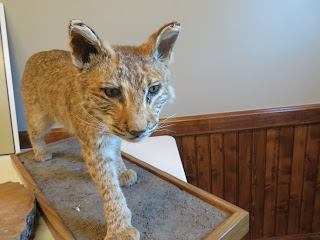Located in Anson and Richmond counties of North Carolina, Pee Dee National Wildlife Refuge, attracts thousands of waterfowl, particularly ducks during their winter migration. According to the manager, JD, a bird count is conducted every Tuesday. Currently there are about 9000 ducks in residence.
The property encompasses both sides of the Pee Dee River just below the Lake Tillery Dam. The Pee Dee is formed in Lake Tillery at the confluence of the Yadkin and Uwharrie rivers. There is significant forested areas as well as agricultural fields. The fields are rotated between corn and soybeans with some other grains as well. The crops are grown as food for the wintering waterfowl. Of course blackbirds, deer and many other animals descend on the crops as well. We saw many deer on the our drive through. In the fall, water is pumped onto the fields from the Pee Dee, so they become a suitable habitat for waterfowl.
Our outing was organized by Three Rivers Land Trust. We had a group of 14. The objective was to see lots of ducks. Unlike other refuges like Lake Mattamuskeet, the ducks here are quite skiddish and take to flight as soon as a vehicle appears. As the ducks fly off from one field, ducks in the next field observe this and also take to the air. It is like a domino effect through all the fields. Often the ducks will fly from one side of the river to the fields on the other side. Thus managers don't know which side of the river the ducks are on. These areas are normally closed to the public. We started out on the Anson county side where there were no ducks. Then drove to the Richmond county side and thousands of ducks began flying up from the fields. JD said we needed to quickly drive from field to field to see them but our group didn't understand that urgency as we watched ducks from distant fields fly off.
The Tuesday duck count routine is a quick one. The vehicles barrel along the gravel roads, bouncing over the potholes and washed out areas. As the ducks fly off, a quick estimate of the numbers is done and its all over in minutes.On our slow drive through, we were able to identify Mallards, Blacks, Ring-neckeds, Pintails and Shovelers. We also spotted a Bald Eagle atop a dead tree. JD mentioned that he had never seen an Eagle get a duck. Apparently, they are not as successful as hunters as we would think. They are observed eating deer carcasses along with Vultures. JD said they attempt to get ducks but he has always seen them miss. The duck just scoots to one side or the other at the moment of impact and the Eagle just gets wet. However, they must have some success since they attempt it often enough.
After our tour, we visited the Visitor Center where a number of mounts can be inspected including a Snowy Owl.











No comments:
Post a Comment